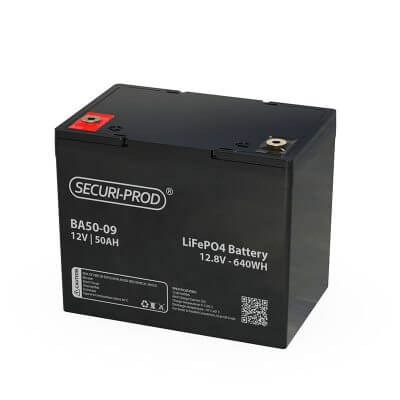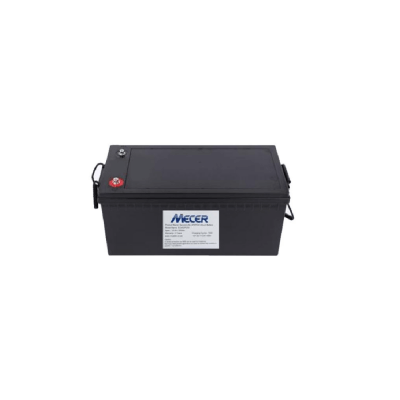To calculate the run time of your Lithium or Lead-Acid battery you will need the following values:
- Volts of the battery
- Ah rating of the battery
- Watts of the load
- The battery’s depth of discharge (DoD: 1.25 = 80% used, 2 = 50% used, 3 = 33.3% used, 5 = 20% used )
- The efficiency of the inverter (60% if you are using a UPS, 85% if you are using a good inverter)
The formula to calculate the battery run time is: ( Remember your BODMAS )
Volts of the battery x Ah rating of the battery / Watts of the load / The battery’s depth of discharge (DoD) x The efficiency of the inverter
Battery Run time = V X Ah / Watts / DoD X Efficiency
OR for easier reading (V x Ah x Efficiency) / (Watts x DoD)
(12 x 100 x 0.85 ) / ( 140 x 1.25 ) = 5.82
5.xx is decimal thus 5 hours and then you take the xx, and multiply it by 60 to get the minutes.
5 hours & 0.82 x 60 = 49.2 which is 49 minutes and 2 seconds.
5.82 = 5h49m Battery Run time
Lead Acid versus Lithium Runtime
Running the lead-acid battery to 50% repeatedly is risky and will tremendously shorten its lifespan, it is much safer to only use 30% of the battery. Lithium you can use 80%+ of the battery ( but we recommend 75% ).
Scenario 1: How long will a 12V 100Ah Lead Acid Battery + Inverter run a Samsung 55″ TV
Let’s assume it’s a Samsung QLED TV, that pulls around 140 watts, this becomes our load and we don’t want to use more than ±30% of the battery to prolong it.
12 x 100 / 140 / 3 x 0.85 = 2.42
(12 x 100 x 0.85 ) / ( 140 x 3 ) = 2.42
A 55″ Samsung QLED TV will run for 2 hours and 25 Minutes on a 100Ah Lead-Acid battery.
Scenario 2: How long will a 12V 100Ah Lithium (LiFePO4) Battery + Inverter run a Samsung 55″
We again assume it’s a Samsung QLED TV, that pulls around 140 watts, thus this becomes our load.
12 x 100 / 140 / 1.25 x 0.85 = 5.82
(12 x 100 x 0.85 ) / ( 140 x 1.25 ) = 5.82
A 55″ Samsung QLED TV will run for 5 hours and 49 Minutes on a 100Ah Lithium LiFePO4 battery.
Conclusion
From the above, we can see that not only will the Samsung TV run much longer on the lithium battery, but it will also be able to do so for far more cycles, running the lead-acid battery in the above scenario will last you 1 maybe 2 years if you are lucky, then you will need to fork out R2 600 again for a new battery.
Ergo: The “rands per cycle” cost is better on Lithium Batteries.
This is where LiFePO4 batteries absolutely shine, longevity as it works out cheaper in the long run. This is especially the case when you have a Paradox or ADT Alarm system, I am willing to bet you have replaced that battery this year already and you will do so again if we hit Stage 6 this year again.
However, if you replace that alarm battery with a 7Ah lithium battery it should last you years, because of the increased cycles and high DoD rate of the LiFePO4 batteries.
Common examples of battery times for various electronics
We will use 30% used for lead acid and 80% used for Lithium in the below examples to err on the side of caution.
The 24 Volt example uses 2 batteries in series, the Ah remains the same, but the voltage doubles, to calculate the Wh of the batteries you simply multiply the Voltage by the Ah;
V x Ah = Wh
Quick fact:
2 x 12v 100Ah lead acid batteries in parralel
12v x 200Ah = 2400Wh = 2.4kWh
2 x 12V 100Ah lead-acid batteries in series
24v x 100Ah = 2400Wh = 2.4kWh
55″ LED TV + DSTV Decoder + Soundbar ( 130 watts )
12 Volt System
12V 100Ah Lead Acid: (12 x 100 x 0.85 ) / ( 130 x 3 ) = 2.61 = 2h36m Battery Run time
12V 50Ah LiFePO4: (12 x 50 x 0.85 ) / ( 130 x 1.25 ) = 3.13 = 3h7m Battery Run time
12V 100Ah LiFePO4: (12 x 100 x 0.85 ) / ( 130 x 1.25 ) = 6.27 = 6h16m Battery Run time
12V 200Ah LiFePO4: (12 x 200 x 0.85 ) / ( 130 x 1.25 ) = 12.55 = 12h33m Battery Run time
24 Volt System
24V 100Ah Lead Acid: (24 x 100 x 0.85 ) / ( 130 x 3 ) = 5.23 = 5h13m Battery Run time
24V 50Ah LiFePO4: (24 x 50 x 0.85 ) / ( 130 x 1.25 ) = 6.27 = 6h16m Battery Run time
24V 100Ah LiFePO4: (24 x 100 x 0.85 ) / ( 130 x 1.25 ) = 12.55 = 12h33m Battery Run time
Desktop Computer PC + 24″ Monitor + Internet Router ( 240 watts )
12 Volt System
12V 100Ah Lead Acid: (12 x 100 x 0.85 ) / ( 240 x 3 ) = 1.41 = 1h24m Battery Run time
12V 50Ah LiFePO4: (12 x 50 x 0.85 ) / ( 240 x 1.25 ) = 1.70 = 1h42m Battery Run time
12V 100Ah LiFePO4: (12 x 100 x 0.85 ) / ( 240 x 1.25 ) = 3.40 = 3h24m Battery Run time
12V 200Ah LiFePO4: (12 x 200 x 0.85 ) / ( 240 x 1.25 ) = 6.80 = 6h48m Battery Run time
24 Volt System
24V 100Ah Lead Acid: (24 x 100 x 0.85 ) / ( 240 x 3 ) = 2.83 = 2h49m Battery Run time
24V 50Ah LiFePO4: (24 x 50 x 0.85 ) / ( 240 x 1.25 ) = 3.40 = 3h24m Battery Run time
24V 100Ah LiFePO4: (24 x 100 x 0.85 ) / ( 240 x 1.25 ) = 6.80 = 6h48m Battery Run time
Game Console ( Xbox / PlayStation ) + 55″ LED TV ( 300 watts)
12 Volt System
12V 100Ah Lead Acid: (12 x 100 x 0.85 ) / ( 300 x 3 ) = 1.13 = 1h7m Battery Run time
12V 50Ah LiFePO4: (12 x 50 x 0.85 ) / ( 300 x 1.25 ) = 1.36 = 1h21m Battery Run time
12V 100Ah LiFePO4: (12 x 100 x 0.85 ) / ( 300 x 1.25 ) = 2.72 = 2h43m Battery Run time
12V 200Ah LiFePO4: (12 x 200 x 0.85 ) / ( 300 x 1.25 ) = 5.44 = 5h26m Battery Run time
24 Volt System
24V 100Ah Lead Acid: (24 x 100 x 0.85 ) / ( 300 x 3 ) = 2.26 = 2h15m Battery Run time
24V 50Ah LiFePO4: (24 x 50 x 0.85 ) / ( 300 x 1.25 ) = 2.72 = 2h43m Battery Run time
24V 100Ah LiFePO4: (24 x 100 x 0.85 ) / ( 300 x 1.25 ) = 5.44 = 5h26m Battery Run time
A note on Depth of Discharge (DOD): This is very important!
DOD is a measure of how deeply a battery is discharged.
When a battery is 100% full, the DOD is 0%. The (Ah)Ampere hours removed from a fully charged cell or battery is expressed as a percentage of rated capacity.
For example, if 25 Ah are removed from a 100 Ah battery, its depth of discharge is 25% and the battery is at a 75% state of charge.
A note on Inverter Efficiency
In short, Efficiency is the ratio of the energy output of an appliance to the energy input, expressed as a percentage. Since appliances require more energy than they provide, some energy is lost.
Sometimes bigger is not better. What we really need to know is what percentage of the power that goes into the inverter from the battery comes out the other side as AC power. To make this calculation even more difficult, the efficiency of an inverter changes with the output load placed on it. if a small load is put on an inverter it may be only around 50% efficient. However, increase the load to near the inverters stated maximum continuous load, and the efficiency will rise to around 90%.
A 3000 Watt inverter may draw around 20 Watts of power from the battery when it is connected and turned on without anything plugged into the output. This power is what the inverter needs to run itself… battery monitoring circuits, alarm circuits, and maybe a small fan.
Now if we plug in a small AC load… say 20 Watts… the total load on the battery is now 40 Watts (20W for the inverter + 20W for the load) so a bit of maths; 40 Watts in and 20 Watts out shows an efficiency of 50%.
Now if we look at this again with a small 150 Watt inverter – connected to the battery with no load it takes about 5 Watts to run the inverter. Now if we plug in the same 20 Watt load we have 5 Watts for the inverter plus 20 watts for the load giving a total load on the battery of 25 Watts. Thus 25 Watts in and 20 Watts out gives us an efficiency of around 80%.
That being said, when choosing an inverter, always go for a slightly higher output (watts) than you think you need. It is better to have a 1000-watt inverter running at 700 watts than a 700-watt inverter running flat-out!
As a rule, assume your inverter is only 80% to 85% efficient and work from there.
Note & Special Thanks: This article uses the wisdom of Dairyfarmer & Geoff.D on MyBroadband in the thread about Inverters and batteries.



















